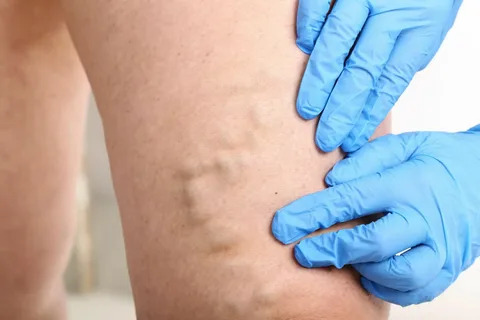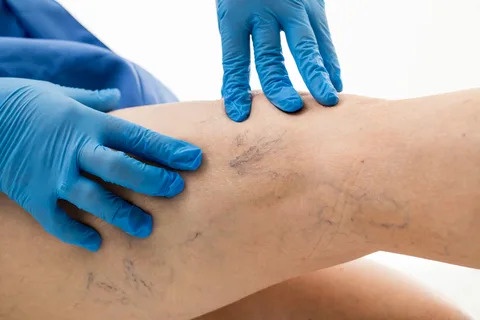Spider veins, medically known as telangiectasia or venulectasias, are small, dilated blood vessels that appear near the surface of the skin. They often appear as thin, branching lines or web-like patterns, resembling the legs of a spider, hence the name. These veins typically measure less than 1 millimeter in diameter and may appear red, blue, or purple in color. Spider veins can occur anywhere on the body but are most commonly found on the legs and face.
Characteristics of Spider Veins
- Appearance: Spider veins are characterized by their thin, wispy appearance, often forming intricate patterns resembling spider webs or tree branches.
- Color: Spider veins can vary in color, ranging from red to blue or purple, depending on the size of the blood vessels and the depth at which they lie beneath the skin.
- Location: While spider veins can develop anywhere on the body, they are most commonly found on the legs and face. On the legs, they may appear as clusters or networks of veins on the thighs, calves, or ankles.
- Size: Spider veins are typically small, measuring less than 1 millimeter in diameter. However, they can sometimes be larger, especially when they occur in conjunction with varicose veins.
- Texture: Spider veins are usually flat or slightly raised and may feel warm or tender to the touch, particularly if they are associated with underlying venous insufficiency or inflammation.
- Symptoms: In many cases, spider veins are asymptomatic and do not cause any discomfort. However, some individuals may experience symptoms such as itching, burning, or aching sensations around the affected area.
Risk Factors for Spider Veins
Spider veins, though often benign, can be influenced by various factors that increase the likelihood of their development. Understanding these risk factors can help individuals identify potential triggers and take preventive measures to minimize their occurrence.
Common Risk Factors
- Heredity: Genetics play a significant role in the development of spider veins. If one or both parents have a history of spider veins or varicose veins, you may be more susceptible to developing them yourself.
- Age: Spider veins become more common with age as the elasticity of the blood vessels decreases and vein walls weaken, making them more prone to dilation and the formation of spider veins.
- Gender: Women are more likely to develop spider veins than men, largely due to hormonal fluctuations associated with pregnancy, menstruation, and menopause, as well as the use of hormonal contraceptives.
- Pregnancy: The hormonal changes and increased blood volume during pregnancy can put added pressure on the veins, leading to the development of spider veins, particularly in the legs.
- Obesity: Excess weight places additional strain on the circulatory system, increasing the risk of venous insufficiency and the development of spider veins.
- Occupation: Jobs that involve prolonged periods of standing or sitting, such as nursing, teaching, or office work, can hinder proper blood circulation and contribute to the formation of spider veins.
- Inactive Lifestyle: Lack of physical activity can weaken the leg muscles and impair circulation, making it easier for blood to pool in the veins and contribute to the development of spider veins.
- Sun Exposure: Prolonged sun exposure can damage the skin and blood vessels, leading to the dilation of superficial veins and the formation of spider veins, particularly on the face and legs.
Tips to Avoid Spider Veins
Taking proactive steps to maintain healthy circulation and minimize pressure on the veins can help prevent the formation of spider veins and alleviate existing symptoms.
Stay Physically Active
Regular exercise, particularly activities that promote leg strength and flexibility such as walking, cycling, or swimming, can improve blood flow and prevent blood from pooling in the veins.
Maintain a Healthy Weight
Maintaining a healthy weight reduces the strain on the circulatory system and lowers the risk of developing spider veins and other vascular conditions.
Elevate Your Legs
Elevating the legs above heart level for short periods throughout the day can help improve circulation and reduce swelling and discomfort associated with spider veins.

Wear Compression Stockings
Compression stockings exert gentle pressure on the legs, promoting blood flow towards the heart and preventing blood from accumulating in the veins.
Avoid Prolonged Sitting or Standing
Taking regular breaks to move and stretch the legs can prevent blood from pooling in the veins and reduce the risk of developing spider veins, particularly during long periods of sitting or standing.
Practice Good Posture
Maintaining proper posture while sitting and standing can help optimize circulation and alleviate pressure on the veins, reducing the risk of spider vein formation.
Follow a Balanced Diet
A diet rich in fiber, antioxidants, and nutrients supports overall vascular health and can help prevent venous insufficiency and the development of spider veins.
Quit Smoking
Smoking constricts blood vessels and impairs circulation, increasing the risk of vascular problems including spider veins. Quitting smoking can improve vascular health and reduce the risk of vein-related conditions.
Skincare Tips to Prevent Spider Veins
Maintaining healthy skin is essential for preventing spider veins and minimizing their appearance. Here are some effective skincare tips to incorporate into your daily routine:
Protect Your Skin from Sun Damage
Exposure to harmful UV rays can weaken the skin's elasticity and lead to the formation of spider veins, especially on the face and legs. Use a broad-spectrum sunscreen with SPF 30 or higher, and reapply every two hours when outdoors. Wear protective clothing and seek shade during peak sun hours to shield your skin from sun damage.
Moisturize Regularly
Keeping the skin well-hydrated can improve its elasticity and resilience, reducing the risk of spider vein development. Choose a moisturizer that suits your skin type and apply it daily, paying extra attention to areas prone to dryness such as the legs, arms, and face. Hydrated skin is more supple and less prone to damage and irritation.
Gentle Skincare Routine
Avoid harsh skincare products and abrasive treatments that can irritate the skin and exacerbate vein-related issues. Opt for gentle cleansers, exfoliants, and moisturizers formulated for sensitive skin. Be cautious when shaving or waxing, and use gentle techniques to avoid damaging the skin's surface.
When to Seek Medical Attention
While spider veins are generally harmless, they can sometimes indicate an underlying vascular condition that requires medical attention. Knowing the signs and symptoms of spider veins can help you determine when to seek professional care:
Signs and Symptoms of Spider Veins
- Appearance of thin, web-like veins on the skin's surface, usually blue, red, or purple in color.
- Pain, discomfort, or heaviness in the legs, particularly after prolonged standing or sitting.
- Swelling or inflammation around the affected veins.
- Itching or burning sensations on the skin.
- Changes in skin texture or pigmentation near the veins.
If you experience any of these symptoms or notice new spider veins developing, consult a healthcare provider or dermatologist for a thorough evaluation. They can assess your condition, provide personalized treatment recommendations, and address any concerns you may have about spider veins and their management.
Conclusion
Spider veins are a common vascular condition that can affect anyone, but with the right preventive measures and awareness, their impact can be minimized. By understanding the factors that contribute to their development and implementing simple lifestyle changes and skincare practices, individuals can significantly reduce their risk of developing spider veins. From maintaining a healthy weight and staying physically active to protecting the skin from sun damage and practicing good posture, there are numerous steps individuals can take to promote vascular health and prevent the onset of spider veins. Knowing when to seek medical attention and recognizing the signs and symptoms of spider veins can help individuals address any concerns promptly and receive appropriate treatment if necessary. While spider veins may not always pose a significant health risk, they can cause discomfort and self-consciousness for some individuals, making prevention and early intervention crucial.


No comments yet